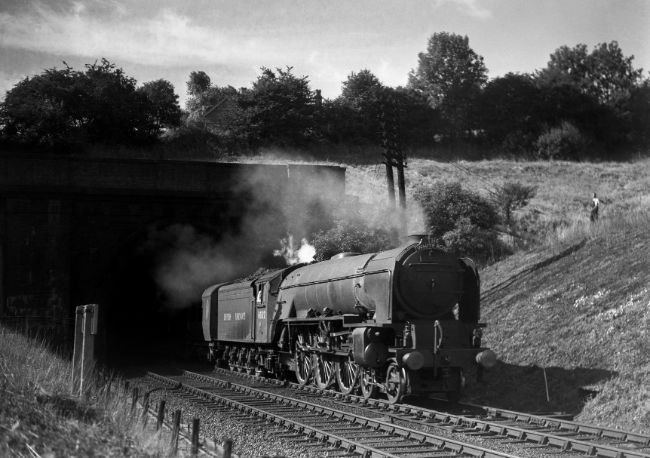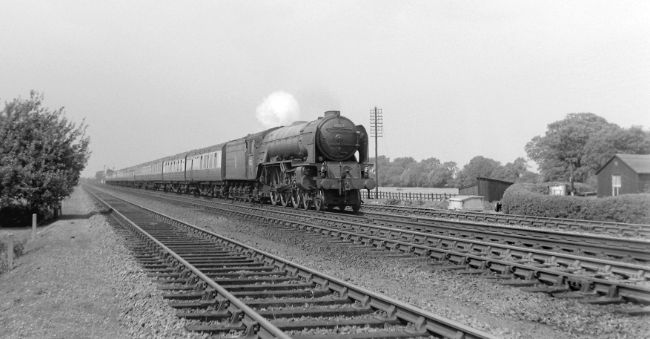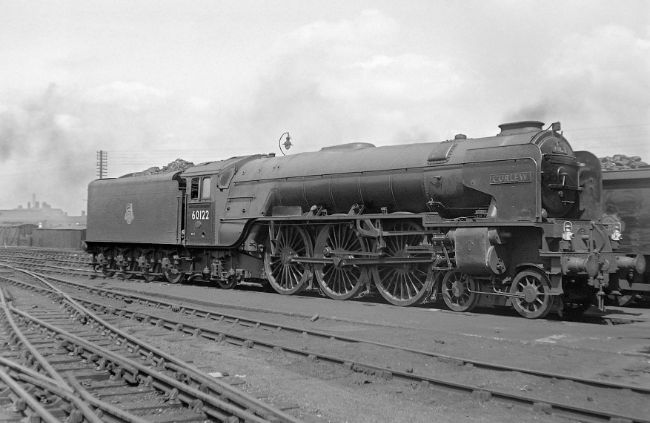One of eight A1s to emerge in December 1948, No. 60122, as Doncaster Works No. 2039, was the ninth to come from ‘The Plant’ but the 19th to enter service. The first report of it was in the Erecting Shop on the 7th with the boiler mounted but wheels not fitted. The 21st found the locomotive on running trials at St. James Bridge, Doncaster. On Christmas Eve No. 60122 entered service from King’s Cross shed. Livery for this plain-chimneyed A1 was the then customary LNER apple green with black and white lining with white block capitals used for the owner’s name on the tender. A Flaman speed recorder was fitted. Apart from visits to Doncaster for repairs the first observation in service was at Cambridge on 1st February 1949. The first train logged was the 10:25hrs King’s Cross to Harrogate on 27th June followed by an up express from Grantham the same day. No. 60122 worked between the capital and west Yorkshire and also to the North East. Named trains hauled included the ‘White Rose’ on 27th August 1949 and the up ‘Tees-Tyne Pullman’ on 26th July two years later. On 12th August 1950 it pulled an up express from Newcastle along the Durham coast route.

No. 60122 at Hadley Wood in 1949 - F.R. Hebron/Rail Archive Stephenson
A repaint into BR express blue had been carried out that May along with three other class members making them the ninth to twelfth A1s so re-liveried. Naming as Curlew took place in July, one of half a dozen A1s to follow the fine LNER tradition of calling locomotives after birds. Altogether seven A1s were named that month. Usually the nameplates were fitted at Doncaster Works during overhaul but No. 60122 was one of a pair to have the plates sent to, and later fitted, by ‘Top Shed’. It was about this time that the Flaman speed recorder was removed and a lipped chimney replaced the plain one. Curlew was among the first A1s to be fitted with the Hudd system of Automatic Train Control. Two consecutive days in October found it logged hauling the Delaval-Holloway ECS through Stockton, on the 16th with eleven bogie coaches and the 17th with eight bogie vehicles, one six-wheeler and two four wheelers.

Curlew is seen at Werrington on 26th July 1952 – Peter Townend
Re-allocation to Grantham took place on 9th September 1951. The area of operation stayed the same. An additional Sunderland-King’s Cross train with twelve bogie coaches was seen leaving Stockton at 08:53hrs on 31st May 1952. Named expresses included the down ‘Flying Scotsman’, failing at Durham on 28th February that year. This working was hauled by a Grantham engine from its home town to Newcastle. Other ‘namers’ were the down ‘Aberdonian’ from the capital on 30th June and 17th July plus the down ‘Scarborough Flyer’ on 19th July. Curlew was one of a pair of A1s repainted in BR lined passenger green in October – well down the list as 38 of the class had been repainted before either of them. A transfer to Copley Hill was made in October 1953, affecting the sphere of operations little. The up ‘Bradford Flyer’ was noted on 15th April 1954. During the previous month Nos. 60122 and 60126 had exchanged tender Nos. 740 and 745 during general repairs.

Curlew at Grantham shed, 1st May 1953 - Peter Townend

No. 60122 Curlew at Grantham, undated – Bill Reed
A return to Grantham shed was made on 28th August 1955. Workings continued to Leeds and the North East. Both the up and down ‘Flying Scotsman’ were seen hauled into Newcastle four times between March and June 1956. From September to the following January Curlew hauled the following trains a number of times; 15:10hrs and 17:35hrs. King’s Cross-Newcastle; 08:20hrs. King’s Cross-Edinburgh; and the 10:20hrs Leeds from the capital. Shorter runs were the 05:50hrs and 06:45hrs King’s Cross-Grantham. The 05:50hrs on Boxing Day was followed by an additional King’s Cross-Hull. Few records exist of No. 60122 on non-passenger trains; one is the 23:00hrs King’s Cross-York parcels on 7th January 1957. The smokebox numberplate and handrail were transposed. In July the later BR crest was applied to the tender.
A return to its original shed came on 15th September 1957. A less usual working was the 06:05hrs King’s Cross-Cambridge. On 11th November 1958 the 17:30hrs from Peterborough to the capital was hauled to Hitchin before stabling on Hitchin shed. Re-allocation to Doncaster came on 5th April 1959. Sightings continued in west Yorkshire and Newcastle with servicing on Gateshead shed. Sightings of Curlew in Lincoln were possible on 8th January 1961 and 11th November because of Sunday ECML diversions. Other workings of note were the Sunday 13:40hrs 1A43 Sunderland-King’s Cross into the capital on 9th July 1961 and the King’s Cross-Huddersfield on the following 7th February. An interesting diagram on 13th September, 20th and 21st 1961 was the 1A12 King’s Cross-Newcastle (for the Tyne Commission Quay) returning with the 3E22 up fish train. These are the only recorded goods workings for No. 60122. Curlew’s last logged train was a ‘namer’, the up ‘Harrogate Sunday Pullman’ of 11th November 1962.

A nice colour study at Doncaster, again undated – Bill Reed
Withdrawal from service was on 17th December 1962. The final sighting was on 13th January in Doncaster Works yard where it was cut up. During its life, No. 60122 had carried seven different boilers. Curlew’s 14 years of service on the East Coast was less than the A1 average of 15 years 2 and a half months although five class members had even shorter working lives. Even though it was amongst the first half of the A1s to be built No. 60122 was just the sixth to be taken out of service at a time when increasing dieselisation was taking away its work.
This history was compiled by Phil Champion based on a database compiled by Tommy Knox and with reference to the RCTS book ‘Locomotives of the LNER Part 2A’ as background. Revised and updated by Graham Langer, April 2020.